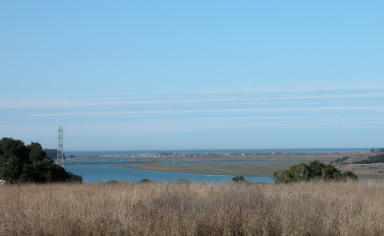There are several modes of transport from land to the ocean, one of which is the atmospheric deposition of
dust and particles. Atmospheric deposition has been widely recognized as a source of both helpful nutrients and
harmful pollutants to coastal ecosystems, particularly in the case of fine aerosols and dust particles, which
can be transported over very long distances. Atmospheric particles may include nitrogen and iron, sulfur
compounds, mercury, pesticides, phosphate, trace metals and other toxic compounds.
Dr. Adina Paytan's research on atmospheric deposition takes place at several sites throughout the world, one
of which is
Elkhorn Slough, which provides a
pristine area to sample particulates found in the atmosphere. Several types of samplers – of rainwater,
aerosols, and mercury deposition – take collections continuously, and samples are analyzed weekly to evaluate
the load of pollutants coming from the air into the slough and neighboring Monterey Bay. A meteorological
station provides the necessary weather data to be factored in.
"Atmospheric deposition is a whole mixture of things – it could bring important nutrients or toxic components, or viruses and fungi" |
In addition to Elkhorn Slough, Adina's lab supports several sites around the globe where atmospheric deposition
is being studied, each of which provides unique conditions: one in the Red Sea, one in Bermuda, and one in
China. "There’s a lot of concern about the impact of Asian dust on coastal ecosystems," says Adina. "It
passes through big industrial sites, and we’ve found that pollutants transported in the air, particularly if
rich in copper or other toxic heavy metals, can actually get to concentrations that are negatively impacting
phytoplankton." These pollutants may contribute to harmful health and environmental impacts such as
eutrophication, contaminated fish and harmful algal blooms. At Elkhorn Slough there are samplers that monitor
mercury, which accumulates in the ecosystem and moves up the food chain.
"These particles have a significant effect, particularly the more offshore you go, because that's the only
external source of new matter into the ocean," says Adina. "It’s a delicate balance between positive and
negative, which varies according to location, which is why we have sites at such a wide array of settings."
Adina's research is providing a baseline, to be used to calculate and predict change in a future that contains
climate change, increased population and industrialization.


